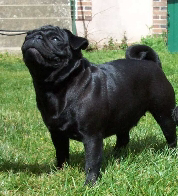The main purpose of this page is to present in few words the Pug breed. It can not be considered as exhaustive.
Breed history
The origin of the Pug as a breed probably begins in ancient China, although it certainly didn't look the same as today's dogs. Dogs known as "short mouthed" dogs are described in writings that date to about 600 B.C. and were probably the forerunners of the modern breed that we call the Pug. Emperor Kang Hsi, about A.D. 950, commissioned a dictionary of all the Chinese characters, and in it there are two references which could describe the Pug: "dogs with short legs" and "a dog with a short head." By the 1300s there were three main types of dogs that are identifiable as founders of breeds of today: the Pekingese, the Japanese Spaniel, and the Pug.
It wasn't until the latter portion of the 1500s and early 1600s that China began trading with European countries such as Portugal, Spain, Holland and England. Small dogs presented as gifts returned from the Orient with the traders, and thus began the rise of the Pug in popularity in Europe. The Chinese had often interbred among the three types of dogs they favored, and so many times breeders would find a long haired Pug among a litter of puppies, as well as white spots on the head.
By the early 1900s, a book called Dogs in China and Japan had been written. This book drew heavily upon the experience of Wang Hou Chun, a servant who had bred and worked with the dogs in the Emperor's Imperial Palace for seventy five years. He used the term Lo-Sze to describe the Pug, noting that the differences between the Pug and Pekingnese were that the Pug always had a short coat, and very supple, elastic skin. Because of the short coat, the Pugs forehead wrinkles were more noticable, and the Chinese were always looking for wrinkles in certain patterns similar to Chinese letter characters. The most highly favored character that the Chinese looked for was the three wrinkles that together denoted the word, "Prince." Many Oriental Pugs, though, had a great deal of white on their bodies, and some were almost entirely white. These white and pinto spotted Pugs are documented in Europe as late as the end of the 1800s, but the lines that produced them were eventually allowed to be lost.
The Pugs that were traded to Europe seem to have first landed in Holland, possibly as a result of the famous trading company, the Dutch East India Company. The Dutch named the breed Mopshond, which is still in use today. Pugs were known to be within the household of William III and Mary II when they ascended to the throne of Great Britain in 1688. Black pugs are known to exist in the 1700s thanks to William Hogarth's painting of one in House of Cards (1730). The artist was a proud owner of pugs (a trait that seems to continue through to today), and depicted many in his paintings so that there is an excellent visual record of the Pugs appearance dating back 250 years.
The Pugs popularity spread throughout Europe, with the breed referred to in France as the Carlin, in Spain as the Dogullo, at the same time, they were Mops in Germany and the Caganlino in Italy. In France, the breed was popularized by Josephine Bonaparte, owner of the Pug named Fortune. Goya painted Pugs in Spain in 1785, showing the breed with cropped ears in his paintings.
By the turn of the century into the 1800s, Pugs became more standardised as a breed, with colors separating and settling into the contemporary "fawn" or "Isabella" and black colors. It is also known the the "black mask" was in place by now, too, as the breed had been referred to as the "Dutch Mastiff" from time to time, harking back the masked face of the much larger Mastiff breed.
The late 1800s saw the beginning of dog shows in England, and Pugs were first exhibited in 1861. The stud book began in 1871, and there were sixty-six Pugs in the first volume. The English Pugs developed mostly along the lines of two strains: the Willoughby and the Morrison lines. Each had consistent breeding traits, and the lines existed for many years as competitors.
Willoughby Pugs were developed by Lord Willoughby d'Eresby and had what is today considered a "smutty coat" because it had a mixing of fawn and black hairs in it. The color has been described as "stone fawn." The heads of these dogs were almost entirely black and they had wide traces, and even saddle marks on their backs (dark patches of hair shaped like the saddle of a horse). Their bodies were thin, and leggy. Mops and Nell were two prominent Willoughby Pugs that can be found as ancestors in Pug pedigrees even today.
Morrison Pugs, in contrast, had rich apricot-fawn colored coats and stocky, cobby bodies. The trace on their backs was very light brown rather than black, and the coats had few, if any, black hairs in them. This line is much more in line with the modern Pug of today. Punch and Tetty were the foundation dogs of the Morrison line. It's not uncommon to hear dogs referred to today as "Willoughby" or "Morrison" type - referring to the darker color of the Willoughby, and the lighter color of the "Morrison."
A major impact on the Pug breed in the 1800s occurred when, in 1860, two Pugs of "pure" Chinese lines were brought to England. These two dogs, Lamb and Moss, produced a son named Click, and Click..well, he clicked! Click was bred many times, and his blood helped to mix the Willoughby and Morrison lines making Pugs a better breed overall and shaping the modern Pug of today as we know it.
("Breed History" from Marcy Heathman web site)

The Pug